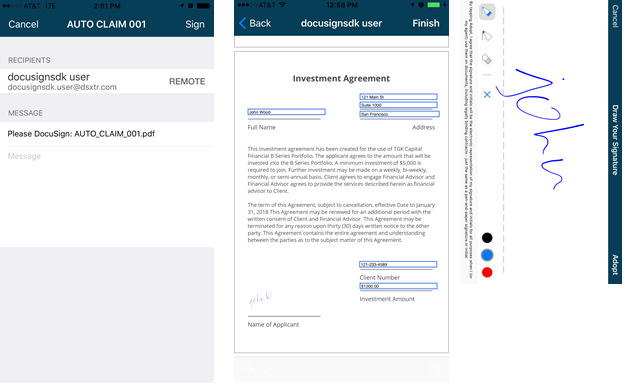Native iOS Offline Templates SDK Released
At DocuSign, we’re committed to helping our customers and developers be as productive as possible. We’re continuously enhancing our products and making more features available. We listen to our customers and strive to alleviate their pain points and friction.
We’ve heard from a number of customers that they would like to use our eSignature technology when internet connectivity is spotty, or even non-existent. Enter offline signing! Offline signing works as the name suggests; it enables users to review and electronically sign (eSign), while not connected to the internet. Offline signing is leveraged in the DocuSign iOS app, available for free in the Apple store. Using the app, if internet connectivity is lost, the completed documents are securely synced with a DocuSign datacenter when the connection is restored. See this video for more information on how offline signing works.
However, if you wanted to incorporate custom functionality into your own app to leverage offline signing, we’ve just released a new Native iOS Offline Templates SDK to make your life easier. To get your creative juices flowing, here are some example use-cases that are perfectly suited for offline signing:
- Field sales representatives that capture sales order details remotely
- Roofing contractors that work in remote locations
- Private bankers collecting financial details in customers’ homes
- Insurance agents filling-out claims onsite
Note: You must have a Business Pro or Enterprise Pro account to use offline signing.
What’s in the Native iOS Offline Templates SDK?
The Native iOS Offline Templates SDK is a dynamic framework that provides native sending/signing UI components (see the next section for more information on those) that can be easily integrated into your iOS apps. The Native iOS Offline Templates SDK supports our very popular template-driven workflows. Using this SDK, you can drag and drop sending/signing UI components into your app with as little as 30 lines of code and avoid interfacing with DocuSign at the service layer.
The Native iOS Offline Templates SDK offers complete documentation and examples using Swift and Objective-C. Each demonstrates most aspects of integration, online and offline signing use of the DocuSign Native iOS Offline Templates SDK.
What are Native Sending & Signing UI components?
The Native iOS Offline Templates SDK contains reusable UI components that make it easy to accept signatures using templates and sign envelopes through a single, unified integration. These pre-built components drastically reduce the time needed to create beautiful, high-conversion iOS signing flows.
The new SDK contains a class called DSMTemplatesManager that is designed to make template-based document sending and signing workflows as easy as possible—and without having to code them from scratch. Some of the pre-built components, shown in the image below) include:
- Adding Recipients – Preset DocuSign Templates enables an easy way to add a recipient’s detail to the envelopes that are sent from your app. The DSMTemplatesManager class exposes various methods to initiate the document sending and signing workflow.
- Signing Ceremony – Template-based document signing ceremony can be used to get signatures from users when there is no network connection. DSMTemplateManager can be used to list, download, and use preset templates with a given DocuSign account. DSMEnvelopeManager provides an interface to query envelopes signed in offline mode and are ready to be synced with DocuSign.
- Sign Pad – Signature pad to capture signatures and initials during the document signing workflow. Signed documents are encrypted and stored securely until envelopes are requested to be synced with DocuSign. This is a very important piece of the SDK. If you are considering developing a DocuSign app with offline signing capabilities, consider that if the cached documents are not encrypted, they can be hacked and changed.

Template-Driven Workflows
Templates help streamline the envelope-sending process when you frequently send the same or similar documents to one or more recipients. Templates enable you to easily create repeatable transactions, while simultaneously providing you the flexibility to modify aspects of the envelope, such as recipients, documents, and workflow. In other words, templates save you time by enabling you to configure your workflow once and reuse those workflow in subsequent requests.
For example, suppose you have a standard NDA your customers may sign at any given time. A template is the perfect solution because you define the NDA template once and send it to recipients, substituting the recipient information at runtime. A template can include multiple documents and can be sent to one or more recipients, using a signing order (or not), and they can be shared across an entire DocuSign account, or be made private per user.
How do I know when use the Native iOS Offline Templates SDK or the Objective-C SDK?
First and foremost, if you need to create a custom iOS app that supports offline signing using template-driven workflows and your DocuSign account permits this feature, the Native iOS Offline Templates SDK is for you. No other DocuSign developer tool enables this functionality (although the standard DocuSign iOS app does provide this functionality, but you can’t customize it).
However, the criteria above are not the only scenarios where you’ll want to use the Native iOS Offline Templates SDK. It can be used in an online configuration also. In fact, the SDK technology for online is exactly the same as offline, only that syncing with a DocuSign datacenter takes place immediately.
The following table helps to illustrate when to use each SDK:
| Feature | Native iOS Offline Templates SDK | Objective-C SDK |
| Core Technology | Objective-C dynamic framework with native DocuSign sending/signing UI components | iPhone/iPad developer access to DocuSign API via Obj-C language service layer |
| Full eSignature API access | No, only template-driven document workflows | No, most API endpoints covered but no offline access or account management endpoints |
| Native Sending & Signing UI Components | Yes | No, developers must build custom UI components to support API requests and responses |
| Offline capabilities | Yes, offline signing driven by templates | No, online only |
| Supports all DocuSign tab types | No, supports signature, initials, name, date, textbox, checkbox, company, and title tabs | Yes, all tab types are available and supported |
| Swift Support | Yes, with sample Swift 3.0 app | Yes |
FAQ
- Q: What DocuSign account plans support offline signing? A: Business Pro and Enterprise Pro.
- Q: Can I try offline signing in a free Sandbox environment? A: For sure. Code away!
- Q: If I don’t have a Business Pro or Enterprise Pro account, can I just use the Native iOS Offline Templates SDK for online-only apps? A: Yes. Consult the above table, but as long as you are using DocuSign templates and don’t need access to the full API, you can use the Native iOS Offline Templates SDK in an online-only configuration.
- Q: When do I use the Objective-C SDK? A: The Objective-C SDK is still supported and is recommended for some scenarios. Consult the table above for more detail, but at a high-level, the Objective-C SDK has access to most eSignature API endpoints and can be used in scenarios that don’t involve templates.
- Q: Can I use the new Native iOS Offline Templates SDK along with the Objective-C SDK? A: Absolutely, just as you would use any other two SDKs simultaneously.
Additional Resources
Get more information about DocuSign’s SDKs and stay up-to-date with DocuSign developer news and information by visiting these additional resources:
